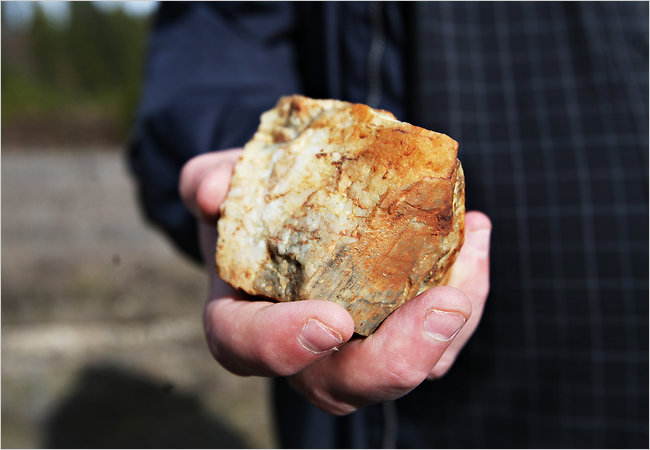In New California Gold Rush, Old Mines Reopen

David Cochrane examining the walls of a Sutter Gold tunnel dug by miners following a vein. “Right there, see?” he said, spotting a speck of gold.
By JESSE McKINLEY Published: February 10, 2011
SUTTER CREEK, Calif. — Standing in a cramped, slanted and slippery crevice some 500 feet below the earth’s surface, David Cochrane turned his eyes to a ribbon of marbled quartz — mainly gray, amber and white — and found the one hue he was actually looking for.

Jim Wilson/The New York Times
The rock above is quartz, but in the Sierra foothills of Northern California, gold can be found in tiny quantities in such ore.
“Right there, see? It’s small but it’s very colorful,” Mr. Cochrane said, pointing at a shiny speck no bigger than a seed. “It’s got that nice yellow color.”
It was gold, and if people like Mr. Cochrane have their way, gold will soon be big business again in California’s Mother Lode, in the same area of the Sierra — and occasionally the same mines — where the old-time prospectors once used pickaxes, ore carts and burros to chase their riches.
“People say the Mother Lode’s mined out,” said Mr. Cochrane, a vice president with Sutter Gold Mining Inc., based in Colorado. “But that’s not the case.”
Sutter Gold is just one of several companies seeking to reignite a stagnant industry in California, a state whose early history and growth were intertwined with gold’s discovery, excavation and exploitation.
Mining largely dried up in California after World War II as price controls made the business model unappealing. But with controls gone, and gold now selling at more than $1,300 an ounce, the math makes sense again.
“The price is there,” said James Hesketh, the president and chief executive of Atna Resources, which reopened the Briggs Mine on the western border of Death Valley National Park in 2009. “It’s still a very well-endowed resource state.”
Sutter Gold estimates that there could be $800 million or more in ore under the 3.6 mile stretch it owns in the Mother Lode. And with most of about three dozen local, state and federal permits already in hand, its new Lincoln Mine could be producing gold as early as next year.
But Sutter Gold will not be the first to get back in the game in California. In addition to the Briggs Mine, which last year produced some 25,000 ounces of gold — or about $30 million worth — there is the Mesquite Mine, in Imperial County on the Mexican border, which reopened in 2008. In 2010, that mine outstripped company estimates to produce nearly 170,000 ounces of gold.
Both the Briggs and Mesquite projects are open-pit mines. But here in the Sierra foothills, where the discovery of nuggets in 1848 set off the global rush of prospectors to California, miners are headed back underground. In addition to the Lincoln Mine, plans are afoot to reopen the Idaho-Maryland mine in Grass Valley, a family-friendly area 50 miles northeast of Sacramento.
That mine — now flooded — has not had hard hats in it since 1956, but a Canadian company is convinced that more than one million ounces of gold were left behind. “This was a world-class ore body,” said David Watkinson, chief executive of the Emgold Mining Corporation, which is spearheading the project.
The Idaho-Maryland project is further from being shovel-ready than the Lincoln Mine: pumping out more than 50 years of water will take time, after all, as does completing a variety of environmental impact reports and permitting processes. And the prospect of a newly opened mine has also been met with opposition from some local activists, whose worries are rooted in both the legacy of the first Gold Rush — including contaminated and sediment-filled rivers and hillsides denuded by hydraulic mining — and by more modern quality-of-life concerns like traffic, noise and water rights.
“We’d be looking at reopening a mine in the middle of a city,” said Ralph Silberstein, the president of a grass-roots group called Citizens Looking at the Impacts of Mining in Grass Valley (or Claim-GV). “Which is not a good idea.”
Like many of the other towns in the Mother Lode, Grass Valley has long since moved its economy away from mining toward things like software and tourism. The Gold Rush itself peaked in 1852, according to the state’s Department of Conservation, when nearly four million ounces were discovered in California. By 1971, when the nation went off the gold standard, less than 2,000 ounces were produced in California.
But the rebound in price has led to a rebound in production. Domestic gold mine production in 2010 increased for the first time in a decade, according to the United States Geological Survey. Nevada is by far the largest gold-producing state, producing roughly four times that of all other states combined.
Early California prospectors used pans and their hands to find nuggets in freezing cold streams. Methods soon became more intrusive, however, with machinery and dynamite being used to dig into hard rock and lethal chemicals like mercury and cyanide used to help process the crushed ore.
And while today’s methods are safer, Izzy Martin, chief executive of the Sierra Fund, a nonprofit group devoted to preservation of the Sierra Nevada, says there are several challenges to mining old mines, including what previous companies might have left behind.
“There’s a lot of toxic materials in there,” Ms. Martin said. “And you have to clean it up.”


